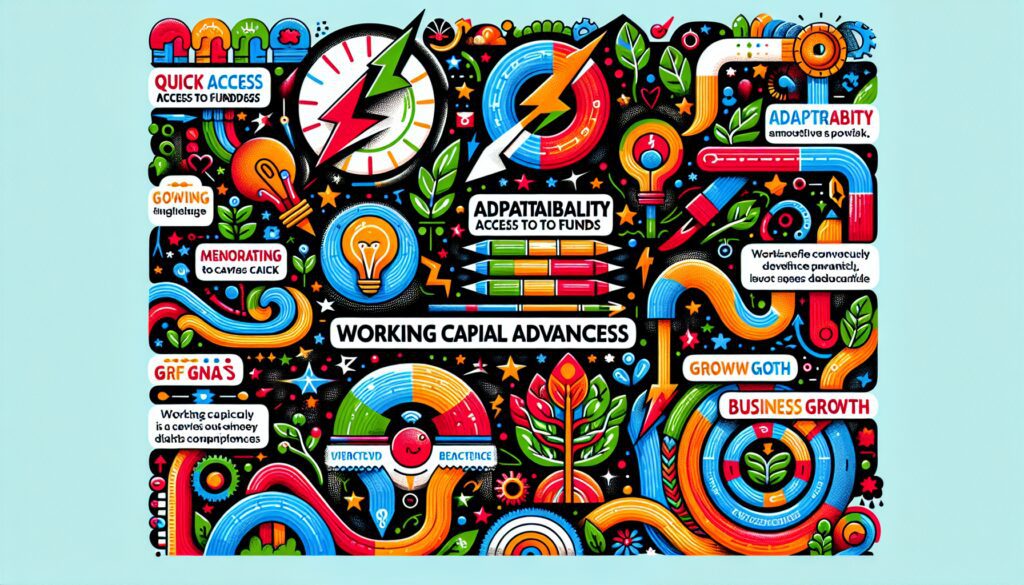Working Capital Lines of Credit for Small Business Owners
This guide will explore the advantages and disadvantages of a working capital loan or working capital advance and application procedures for small businesses seeking swift financial assistance to manage routine costs such as payroll and inventory. It is designed to help you determine whether this type of funding aligns with your business needs.
Key Takeaways
- Working capital loans or advances provide quick funding to small businesses facing short-term cash flow challenges, enabling them to cover essential operational expenses.
- While beneficial for maintaining liquidity and addressing immediate financial needs, working capital advances can carry higher interest rates and potentially complicate cash flow management due to repayment structures tied to sales.
- Businesses must compare working capital advances with other financing options, such as business lines of credit and invoice factoring, to choose the most suitable solution for their specific financial situations.
Small Business Working Capital Advances

What is a Working Capital Loan?
A working capital loan primarily assists businesses in overcoming short-term financial challenges, ensuring that their day-to-day functions continue seamlessly. Small companies must maintain a healthy level of working capital to meet immediate liabilities and sustain operations during periods when revenue may be low. Such a loan can become vital by offering swift access to funds necessary for essential business expenses like employee salaries, premises rent, and stock purchases.
Invoice factoring is permanent working capital that turns 30- 90-day-old invoices into same-day positive cash flow every week.
Inconsistent accounts receivable often result in liquidity issues for small enterprises. This is where the value of working capital loans becomes evident. These advances prove particularly advantageous for companies with seasonal sales patterns that yield fluctuating income across different times of the year. A retailer facing brisk trade over holiday seasons yet grappling with overheads during slower months might use a working capital advance as an effective tool to ensure continuity throughout the year.
Without adequate cash reserves or operating funds—collectively known as working capital—a business could struggle to afford workforce compensation or secure inventory, risking operational interruptions. Startups experiencing rapid growth phases can leverage these loans immediately to address scaling requirements, which allows them to take advantage of emerging market opportunities without a hurdle.
Accessing such small business funding sources proves crucial for small ventures that preserve solvency while achieving optimal functioning conditions. It enables them to manage everyday financial obligations efficiently while maintaining general stability within the enterprise.
Introduction
Working capital loans are critical for small businesses, providing the essential liquidity to maintain operations and pursue growth opportunities. These loans address cash flow gaps caused by unexpected expenses or seasonal fluctuations, allowing businesses to allocate funds for various operational needs such as payroll, inventory, and marketing. The flexibility of working capital loans makes them attractive for companies looking to stabilize their finances and ensure smooth day-to-day operations.
Effectively using working capital loans maximizes their benefits and ensures business stability. These loans enable businesses to overcome cash flow challenges and concentrate on growth and expansion.
This guide will explore the various aspects of working capital advances, including their benefits and drawbacks, how they compare to other funding options, and tips for managing them effectively.
What Is a Working Capital Advance?

Working capital advance is a financial tool designed to help small businesses manage short-term cash flow challenges by providing quick funding for everyday operations. These advances are essential for covering operational costs such as payroll, inventory, and other day-to-day expenses, ensuring that businesses can operate smoothly without significant delays. For many companies, working capital advances are a lifeline that helps them fill funding gaps and manage revenue fluctuations, particularly during slow periods or seasonal downturns.
Working capital is straightforward: it refers to the funds used to cover day-to-day operations, which is determined by the formula: current assets minus current liabilities. This calculation helps businesses understand their financial health and the liquidity available for immediate needs. Working capital advances typically offer quick access to cash, with flexible repayment plans tied to sales, making them an ideal solution for businesses facing short-term financial challenges.
Working capital advances are particularly beneficial for seasonal businesses that face uneven revenue throughout the year. For instance, a manufacturing company might experience high demand during certain months but struggle to cover expenses during the off-season. In such cases, a working capital advance can provide the necessary liquidity to keep the business operational until revenue recovers.
How Does a Working Capital Advance Work?
Owners of small businesses in need of funding should grasp the concept of working capital advances. These financial instruments are crafted to assist with daily expenses and fill cash flow shortfalls, offering a swift provision of funds that can be transferred as quickly as the next business day once an application is approved. This rapidity is advantageous for businesses in immediate fiscal distress, providing them the means to meet pressing operational costs without delay.
Working capital advances are generally issued as lump sums, with daily or weekly repayment conditions. The frequency of payments can vary from twice monthly to weekly or even daily, depending on what has been arranged between the borrower and lender. Companies find these terms accommodating by tying repayments incrementally to their revenue generation cycles.
The length commonly associated with such an advance ranges from three months to one year, which grants small businesses ample time to stabilize their cash flows before full reimbursement of said advance. Given this leeway and fast fund accessibility, many smaller enterprises view working capital advances favorably.
For business owners who aim to smartly utilize financial tools to overcome liquidity hurdles and maintain uninterrupted operation workflow, fully comprehending how these advances function proves essential in informed decision-making processes.
Benefits of a Working Capital Advance

A key advantage of working capital advances is their expedited and straightforward process for obtaining funds. These advances contrast with conventional loans, which are often bound by rigorous lending criteria and protracted approval timelines. They provide swift financial support that can be critical for businesses in need. The prompt availability of these funds—often within days or a few weeks—is essential for companies facing immediate monetary demands to afford expenses like inventory restocking, promotional activities, and employee salaries.
One of the salient features of working capital advances is that they do not influence business credit lines. This characteristic renders them an adaptable financing alternative suitable for small enterprises. Financial products frequently come without collateral requirements, streamlining the application journey, especially for entities possessing scant resources. This has been deemed instrumental in fostering growth among many recipients. Indeed, 83% have testified to positive developments within their operations after securing such funding.
To facilitate flexibility regarding eligibility and access, working capital advances offer customizable repayment options pegged directly to sales revenue shares through automatic deductions—a practice aligning payments closely with cash flow variations. This synchronization gives businesses greater command over fiscal planning while ensuring repayments proceed sustainably alongside income generation, thus mitigating undue stress on available finances.
Collectively, these characteristics underscore why working capital advances stand out as appealing solutions for bolstering liquidity and fueling expansion ambitions within smaller-scale commerce contexts.
Drawbacks of a Working Capital Advance

Merchant cash advances can provide numerous advantages, yet they also entail certain disadvantages that companies must consider. A primary downside is the higher interest rates linked with these financial tools, which increase their expense as a funding option. Due to such elevated costs, using merchant cash advances for larger business projects might be impractical since the high interest charges add to the borrowing cost.
Opting for a merchant cash advance may encumber future revenue streams as repayments are contingent on incoming sales figures. This model could lead to liquidity problems within an organization, especially if it becomes overly dependent on this particular mode of financing.
It’s crucial for businesses to carefully consider these potential negatives alongside the positives and evaluate their unique fiscal circumstances before deciding to take out a working capital advance.
Comparing Working Capital Advances to Other Funding Options
When evaluating financing solutions, weighing the pros and cons of working capital advances against other funding methods is critical. Each approach brings advantages and challenges so that a thorough analysis can guide businesses toward the most beneficial choice. These alternatives include merchant cash advances, business lines of credit, and invoice factoring.
Each alternative presents specific features that may be more fitting for distinct operational requirements. Merchant cash advances often feature an expedited approval process along with adaptable repayment terms, whereas business lines offer repeated access to capital contingent on need.
Conversely, turning over unpaid invoices for immediate funds through invoice factoring services enhances cash flow. The sections below explore these comparisons in greater detail to help you better understand their comparative value against working capital advances.
Merchant Cash Advances vs. Traditional Loans
Merchant cash advances provide a quicker route to funding than traditional loans. They boast an expedited approval process that can benefit businesses in immediate need of capital. The more rigorous criteria and extended wait times associated with standard loan applications are bypassed, highlighting the appeal of merchant cash advances for those seeking swift financial infusion.
Yet this expediency comes with a price tag. Merchant cash advance interest rates vary widely—they might be as low as 3% or soar up to 99%, whereas regular bank loans typically offer interest rates ranging from around 6% to an upper limit close to 99%.
Repayment terms for merchant cash advances adapt fluidly with a business performance by aligning deductions with daily credit card revenue percentages. This creates a direct link between repayment and current cash flow, which is beneficial during periods when sales peak but may present difficulties if business activity slows.
Working Capital Advances vs. Business Lines of Credit
Flexible borrowing options like business lines of credit can help businesses access funds on demand and effectively manage working capital fluctuations. In contrast to lump-sum advances for working capital, lines of credit offer a continuous source of financing that caters well to the variable financial demands businesses might face. The interest rates tied to unsecured business lines are typically between 1.75% and 9.75% above the Wall Street Journal (WSJ) Prime Rate.
On the other hand, while opting for a business line of credit, one often encounters the prerequisite of having a personal credit score exceeding 680, which might be challenging for some enterprises to meet. Conversely, those with lower personal credit may find it easier to qualify for working capital advances, partly because they usually have less stringent eligibility requirements.
Ultimately, when deciding between these two financing methods—whether pursuing a business line or obtaining an advance in working capital—companies should weigh their individual fiscal needs against their current ability as reflected by their credit profiles.
Invoice Factoring vs. Working Capital Advances
Invoice factoring is a financial transaction in which businesses sell their accounts receivable to a third party at a reduced rate to improve their cash flow quickly. By doing this, companies can unlock between 85% and 95% of the invoice value immediately, which can be critical for maintaining day-to-day operations. Once customers pay these outstanding invoices, the business receives the balance minus any fees the factoring company charges.
Unlike working capital advances that require regular repayment schedules with interest, invoice factoring provides an influx of funds without obligating future earnings or creating recurring debt obligations. It also includes an added layer of security against customer non-payment risks since those become the responsibility of the factoring entity once they purchase your receivables. The assurance against default and immediate liquidity makes it appealing for businesses whose ledgers have substantial amounts due from clients.
On another note, both solutions serve as means to access the capital needed swiftly. Working capital advances come attached with fixed repayments tied to expected sales that may deplete resources during periods when revenues wane. Consequently, choosing either invoice factoring or pursuing work capital loans hinges on evaluating each organization’s unique fiscal situation and revenue trends carefully.
Who Should Consider a Working Capital Advance?

Advances in working capital offer significant support to companies grappling with cash flow issues caused by delayed customer payments. Businesses that undergo seasonal declines find these advances essential for keeping their operations running smoothly during periods of reduced activity. Retailers, for example, who face varying sales trends, can leverage such financial support to cover monetary shortfalls and maintain consistent operational activities throughout the year.
Emerging businesses with difficulties obtaining standard financing due to a weak credit history can gain markedly from working capital advances. These funding options typically have more lenient qualifying requirements, allowing enterprises with suboptimal credit scores access needed funds.
Entities aiming at market expansion might resort to working capital advances to secure the requisite funds for their early-stage business endeavors. This provides them with the vital liquidity required to support growth pursuits and venture into new commercial territories.
How to Apply for a Working Capital Advance
Securing a working capital loan can be efficient, particularly when engaging with alternative online lenders offering expedited and simplified application steps. Applications for merchant cash advances can often be filled out and submitted within one business day, allowing quick access to required funds. The time taken for approval varies from lender to lender. Some may provide instant decisions, while others might take several weeks.
To apply for a working capital advance, specific documentation is Needed, including financial records such as bank statements, tax returns, and your strategic business plan. Often, you will need the last 12 months of bank statements and two years’ worth of tax returns complemented by an exhaustive plan detailing how you intend to utilize the borrowed capital. Processes can differ depending on what kind of funding is being applied for and what criteria the lending institution has set forth.
Preparing all pertinent paperwork ahead of time, coupled with thorough research into potential lenders, ensures that you find optimal terms and interest rates tailored to your needs—thus ensuring that the application proceeds seamlessly. Online lenders tend to streamline this procedure compared to traditional banking institutions, granting businesses easier access to essential merchant cash without excessive red tape or delays.
Tips for Managing a Working Capital Advance
Effective management of a working capital advance is crucial to ensure that the funds are used efficiently and that repayment obligations are met. Establishing a budget and repayment plan can help businesses avoid straining their cash flow and ensure timely advance repayment. It’s also important to borrow only the necessary amount to prevent overwhelming debt and maintain healthy cash flow.
Detailed records of all expenditures and debt payments related to the advance are crucial for accountability and financial planning. Keeping an open line of communication with the lender can help address any repayment issues promptly and avoid potential financial difficulties.
Carefully reviewing all terms and conditions of the advance and avoiding personal use of the funds allows businesses to effectively manage the working capital advance and support their operational needs.
Alternatives to Working Capital Advances
Seeking alternatives for financing is key when faced with short-term cash flow issues, and relying solely on working capital advances may not always be sustainable. Businesses must consider various strategies to boost their cash flow. Among these are business credit cards, SBA loans, and short-term loans, each offering unique advantages and potential disadvantages.
Short-term loans can quickly supply funds necessary for immediate company expenses with the expectation of repayment typically within a year or less. This option aligns well with urgent financial needs. Business credit cards provide a flexible funding source with the benefit of potentially aiding in building corporate credit if managed wisely.
In contrast, SBA loans offer more favorable interest rates and extended repayment schedules compared to other options. They require borrowers to navigate an extensive application process and meet stringent qualifications.
By considering such diverse alternative financing solutions, including but not limited to those mentioned above, businesses can tailor their approach towards obtaining suitable financing that upholds robust cash flows while facilitating expansionary pursuits.
Short-Term Loans
Startups often opt for short-term loans when they require quick access to capital, as these loans are usually due within a year or less. These types of financing help companies navigate periods when expenses exceed income by providing the essential liquidity needed for day-to-day operations. Instead of variable interest rates, cash flow loans come with fixed fees that allow businesses to plan their repayments reliably.
It is crucial to remember that significant expenditures such as purchasing real estate or equipment typically fall outside the scope of what short-term loans can finance. Hence, they’re best suited for handling operational costs rather than significant investments. The convenience of short-term funding might come at a higher cost, which necessitates prudent financial management so as not to compromise future earnings.
By carefully considering these considerations, as MCA loans can be expensive, enterprises can effectively leverage short-term and cash-flow loans to meet pressing financial obligations without disrupting long-term fiscal stability.
Business Credit Cards
Business credit cards are tailor-made to aid small business owners in efficiently handling expenditures and securing prompt capital for unexpected short-term financial requirements. Utilizing a business credit card can bolster a company’s credit rating, opening the door to Monetary advantages and improved financing opportunities. They offer an adaptable means of finance that meets diverse fiscal demands, enabling enterprises to meet regular costs promptly.
When small businesses judiciously manage their business credit card usage, they cultivate a robust record of timely payments and strengthen their overall creditworthiness. Responsible stewardship can unlock larger lines of credit and more favorable lending conditions—key factors contributing to greater financial security and avenues for expansion.
Business credit cards are indispensable instruments for smaller enterprises that aim to navigate immediate monetary obligations with agility and elevate their long-term fiscal profile.
SBA Loans
Small businesses often prefer SBA loans due to their lower interest rates and longer repayment terms. The Small Business Administration (SBA) offers various loan programs, with the 7(a)-loan program being the most popular for providing financial assistance to small businesses. These loans can be used for working capital, equipment purchases, and renovations, making them a versatile financing option.
However, qualifying for an SBA loan can be challenging due to the lengthy application process and strict eligibility criteria. Businesses may need several years in operation to qualify, and the approval process can take as long as 90 days. Additionally, SBA loans often require a personal guarantee and multiple criteria to satisfy, which can be a hurdle for some businesses.
Despite these challenges, the benefits of lower interest rates and favorable repayment terms make SBA loans an attractive option for businesses seeking long-term financing solutions. Overall, SBA loans provide a reliable funding source for companies looking to support their growth and operational needs. Businesses can effectively leverage SBA loans to achieve financial goals by understanding the application process and eligibility requirements.
Summary
Working capital advances offer a valuable solution for small businesses facing short-term cash flow challenges. These advances provide quick and flexible funding options, allowing businesses to cover operational expenses and maintain smooth operations during lean periods. However, weighing the benefits against the drawbacks, such as higher interest rates and potential liquidity issues, is essential.
By comparing working capital advances to other funding options like merchant cash advances, business lines of credit, and invoice factoring, businesses can make informed decisions about the best financing solution for their needs. Additionally, exploring alternatives such as short-term loans, business credit cards, and SBA loans can provide further financial stability and support growth initiatives. Understanding and effectively managing working capital advances can help businesses maintain healthy cash flow and achieve their financial goals.
Frequently Asked Questions
What is a working capital advance?
A working capital advance is a financial option for small businesses to manage short-term cash flow challenges. It provides prompt funding for daily business activities. This alternative ensures continuous operations by offering support during periods of variable cash flows.
Please read the top working capital loan options for small businesses.
How does a working capital advance work?
An advance on working capital promptly provides a lump sum of funds, which is repaid in daily or weekly installments correlated with your sales volume.
Employing this strategy helps to maintain consistent cash flow while addressing the requirements of your business.
What are the benefits of a working capital advance?
An advance in working capital offers expedited funding availability, which can be utilized for daily business activities, thus facilitating the possibility of expanding the enterprise.
Employing this financing instrument can significantly improve the management of cash flow.
What are the drawbacks of a working capital advance?
An advance on working capital might result in increased interest rates and cash flow problems, making it challenging to repay the loan as it can encumber forthcoming revenue streams.
What are some alternatives to working capital advances?
Alternative financing options to working capital advances include SBA loans, business credit cards, and short-term or term loans. Each is designed to cater to distinct needs within a business setting.
Before selecting one of these financial solutions, it’s critical to evaluate each one’s advantages and disadvantages thoroughly.
